City guides


Baton Rouge Travel Guide
Situated about 75 miles (121 km) northwest of New Orleans, the state capital Baton Rouge is right in the middle of plantation country along the Great River Road. Surrounded by sugarcane fields, grand plantation homes, and isolated southern mansions.
Beautiful gardens flower along the banks of the mighty Mississippi, the city teems with both historic buildings and a vibrant nightlife. Named by French explorer D'Iberville about 300 years ago when he found a red stick on a bluff overlooking the river.
Today, the one-time swampland settlement is one of the largest port cities in the USA, known for its riverboat casinos where high-stakes gambling, entertaining stage shows and Cajun cuisine reign supreme.
The city has an academic side too, being home to Louisiana State University and Southern University, the largest historically African-American university in the country. There are museums aplenty, art galleries, a planetarium and active theatre and ballet companies.
Incidentally, Baton Rouge also has the tallest capitol building in the United States: the art deco construction, built in 1932 to house the Louisiana seat of government, soars 34 storeys into the air.
Things to do in Baton Rouge
As the city is located in the heart of plantation country, travellers to Baton Rouge should not miss the opportunity to explore some of the stately country mansions. There are many such estates in the Baton Rouge area, of which San Francisco Plantation is a sterling example.
Travellers should follow this visit up with an excursion to the Rural Life Museum and Windrush Gardens to get a real feel of what life was like in the area's past. Another popular plantation house is the 18th-century Magnolia Mound Plantation, a house seemingly frozen in time and surrounded by old oak trees.
Visitors can comfortably explore on foot the picturesque downtown area, where most travellers find accommodation. Many of the city's prime sightseeing attractions are in this area, including the Louisiana State Capitol and the USS Kidd Veterans Museum.
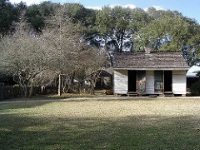
Rural Life Museum and Windrush Gardens
Situated on the Burden Research Plantation, run by the Louisiana State University, is the Rural Life Museum and Windrush Gardens. The museum features an extensive collection of tools, household utensils, furniture, vehicles and farming implements, some outdoors and others housed in some 32 historic buildings that depict the lifestyle of pre-industrial 19th-century Louisiana. Once visitors are finished reliving the past, they can take a stroll through the Windrush Gardens, which are spread over 25 acres and feature majestic oaks and ancient crape myrtles. The Rural Life Museum is set in very pretty grounds and is a popular wedding venue.
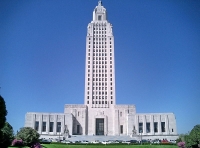
Old State Capitol
The historic Old State Capitol building, once described by Mark Twain as being the 'ugliest thing on the Mississippi', sits on a bluff overlooking the river and today operates as a museum for political and governmental history. The unusual building, completed in 1849, housed the Louisiana Legislature until Union forces captured the city of Baton Rouge in 1862. The legislature returned to the building in 1882 and stayed until construction ended on the new capitol in 1932. Now fully restored, the old Capital offers interesting and interactive exhibits, with multimedia presentations detailing Louisiana's past. This attraction will appeal to those interested in the political history of Louisiana but may be a bit dry and academic for kids and teenagers.
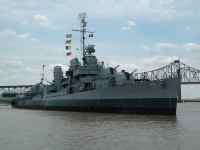
USS Kidd Veterans Museum
A highlight of the Baton Rouge Nautical Center and USS Kidd Veterans Museum is the restored 369ft (112m) World War II Fletcher Class Destroyer, USS Kidd (once known as the 'Pirate of the Pacific'), which is the prime exhibit. The ship is a National Historic Landmark and a memorial to the US veterans of World War II. Overnight camping experiences on the ship are offered, while the centre also features a huge collection of model ships, a restored World War II fighter plane, a jet fighter from the Vietnam era and a walkthrough exhibit of the gun deck of Old Ironsides. Lovers of military history, and naval history in particular, will relish this attraction.
San Francisco Plantation
Louisiana's most authentic restored 'great house' is the San Francisco Plantation house, situated on the east bank of the Mississippi under centuries-old live oaks, about 40 minutes from downtown Baton Rouge and near the small town of Garyville. Built in 1856 by Edmond Bozonier Marmillion, the galleried house reflects the Creole open-suite style. The home features five hand-painted mural ceilings, faux marble and bois wood graining, and one of the finest antique collections in the United States. Also on the plantation is an 1830s slave cabin, a one-roomed schoolhouse, and a museum store. Throughout the day, period-costumed guides take visitors on tours lasting about 45 minutes. Other plantation houses open to the public on the Great River Road between New Orleans and Baton Rouge include Oak Alley, Nottoway, Laura, Madewood and Tezcuco.
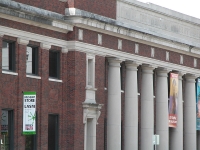
Louisiana Art and Science Museum
Housed in a historic railroad depot, the Louisiana Art and Science Museum offers educational and entertainment opportunities for visitors of all ages. Featured are changing fine art exhibitions, interactive art and science galleries for children, an Egyptian tomb and a simulated space station. The enormous skull of Jason the Triceratops singlehandedly justifies a visit for many. Also on the site is the Irene W. Pennington Planetarium and ExxonMobil Space Theatre, offering planetarium shows and large-format films. Capital Transportation Corporation buses on the Florida Boulevard route stop on River Road directly across from LASM making the museum easily accessible on public transport.
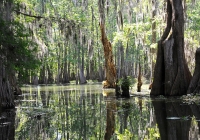
Lafayette
The city of Lafayette is the hub of the eight-parish area in the heart of Louisiana's southern Acadian region, famed for its unique Cajun and Creole heritage, and where the French language is soft on the ear and French traditions prevail. Lafayette, to the east of Baton Rouge, lies at the intersection of Interstate 10 and Interstate 49. Known for its great food, music, and festivals, it also has historic attractions, majestic plantation homes, vibrant gardens, leisurely swamp tours and fascinating museums to entice visitors. Authentic Cajun and Creole cuisine served up with original zydeco and Cajun music is usually top of the lists for tourists, but sites such as the Acadian Cultural Center, the Hilliard Art Museum at the University of Louisiana at Lafayette, and the Natural History Museum are all well worth visiting. Lafayette is only a short drive away from Baton Rouge and is comfortably explored in a day. Although, there is certainly enough about to see and do to justify a weekend getaway.
Getting Around
Public transport options include buses and trolley buses. Buses go all over the city but run infrequently. The Capitol Park Trolley, which provides free service around the downtown area, is a great way to explore Baton Rouge.
The trolleys run between Monday and Friday, 10.30am to 2.30pm. Renting a car is also a good option. The minimum age for this is usually 25, although some agencies only require drivers to be 21 years of age.
Keep in mind that Baton Rouge is a much busier place than it once was. When Hurricane Katrina hit nearby New Orleans, many people evacuated to Baton Rouge, and a lot of them stayed. Many roads and highways now experience significant congestion regardless of the time of day.
Baton Rouge Climate and Weather
Baton Rouge is quintessentially warm and wet. The city experiences rain showers all year round, high temperatures and humidity during summer, and generally warm, sunny winter weather. The climate of Baton Rouge can be unpredictable sometimes, and cold spells have been experienced in winter, with even the odd unexpected snowfall.
Temperatures in summer (May to August) range between 71°F (22°C) and 92°F (33°C), while in winter (November to February) temperatures range between 41°F (5°C) and 64°F (18°C). The best time to travel to Baton Rouge is between February and April, when the weather is usually fine and the heat and humidity are not at peak levels.
United States of America travel info
Electricity
The electrical current is 120 volts, 60Hz. Plugs are mainly the type with two flat pins, though three-pin plugs (two flat parallel pins and a rounded pin) are also widely used. European appliances without dual-voltage capabilities will require an adapter.
Language
English is the most common language spoken but Spanish is often heard in the south-western states.
Money
The official currency is the US Dollar (USD), which is divided into 100 cents. Only major banks exchange foreign currency. ATMs are widespread and credit cards are widely accepted; Apple Pay and Google Pay are very popular. Banking hours are Monday to Friday 9am to 3pm.
Tipping
A 15 percent tip is expected by taxi drivers, bartenders, hairdressers and waiters, but travellers shouldn't tip in fast-food or self-service restaurants. In expensive restaurants or for large parties, the tip should be 20 percent of the bill. It's normal to tip staff such as valets and porters in hotels; this is discretionary, although a minimum of $5 is expected. Most services are customarily tipped if the service is good.
Health
There are no specific health risks associated with travel within the USA. Medical facilities are excellent, but expensive. Only emergencies are treated without prior payment and treatment can be refused without evidence of insurance or proof of funds. Good medical insurance is essential.
Safety
Travel within the United States is generally trouble-free, though travellers should be aware that the US shares with the rest of the world an increased threat from terrorist incidents. Security has been heightened, particularly at airports. Restrictions on hand luggage apply and travellers are advised to check on the latest situation with airlines in advance. Travellers should also be alert to the dangers of car and street crime in cities and should use common sense and take basic precautions. Hurricanes are common between June and November, putting the southern USA, including the Gulf Coast and the eastern US at risk. There's a risk of wildfires in many dry areas in the US, particularly on the West Coast from March to November.
Local customs
Laws vary from state to state, including speed limit, fines and punishment. The age at which alcohol may be legally bought and consumed is 21 years.
Doing business
In such a large country, filled with so many diverse groups, business practices may differ according to each state, though rarely to any large degree. The East Coast is traditionally more formal than the West Coast, though in states such as California, dress code and conservative appearance are as common as they would be in New York. Punctuality is important throughout the country and it's considered rude to be late for a meeting. Gift-giving is uncommon as it may be construed as bribery. Appropriate titles (Mr, Mrs, Ms) are used upon introduction and until otherwise stated. Americans favour politeness and greetings of 'Hello' and 'How are you?' are often expressed with sincerity. Business hours may vary in each state, but an 8am start and 5pm finish Monday to Friday is the most common with an hour over lunch.
Status and age are not necessarily indicative of seniority, nor do they carry much weight in themselves. Those doing business in the States should be mindful of this fact; foreigners should never make assumptions about someone's position or rank. Best practice is to be respectful to all parties. That said, the US upholds a hierarchal business structure in which 'the boss' is the ultimate decision-maker. Senior leaders have the power of the last word, and can go against the grain just as easily as they can follow popular opinion. Foreigners should concentrate on winning over this individual, even if the greater group seems unsupportive. Americans value a direct style of communication. In this fast-paced, consumer culture 'time is money', and small-talk is viewed as unnecessary and wasteful. It's best for foreigners to get to the point quickly, speak about issues in a frank and open manner, and to avoid taking offence if someone questions or challenges them outright.
Duty free
Travellers to the United States who are returning residents of the country do not have to pay duty on articles purchased abroad to the value of $800 provided their stay was longer than 48 hours and their duty-free allowance was not used in the 30-day period prior. For passengers arriving from Samoa, Guam and the U.S. Virgin Islands, a duty-free allowance of $1,600 is allowed. The following items are included in this: 50 cigarettes and 10 cigars and 150 millilitres (5 fl. oz.) of alcoholic beverages or 150 millilitres (5 fl. oz.) of perfume containing alcohol. Restrictions may apply to goods from Cuba, Iran, North Korea, Burma (Myanmar), Angola, Liberia and Sudan. It is prohibited to import Cuban cigars from any country.
Travellers to the United States who are non-residents do not have to pay duty on the following items: 50 cigars or 200 cigarettes and gifts to the value of $100 provided their stay in the USA is not less than 72 hours and that the allowance has not been used in the preceding six-month period.
Prohibited items for residents and non-residents include meat or meat products, poultry, narcotics, absinthe, plants, seeds, vegetables, fruits, soil, live insects and other living plants or animal pests. Fish is prohibited unless it carries disease-free certification. Wildlife and animals or their by-products carry restrictions. Dairy products and eggs from specified countries are not allowed. Firearms and ammunition are not allowed without the necessary license and permit.
Communications
The international country dialling code for the United States is +1. Mobile networks cover most of the country, especially all urban areas; travellers can purchase local prepaid SIM cards for unlocked phones or use eSIMs if their cellular providers support it on their networks. WiFi is widely available.
Passport & Visa
It is highly recommended that travellers' passports have at least six months' validity remaining after the intended date of departure from them travel destination. A visa is required for short visits unless travellers qualify for entry under the Visa Waiver Program.
The Visa Waiver Program (VWP) enables citizens of certain countries to travel to the US for a stay of up to 90 days without a visa. Visitors under the VWP need a valid Electronic System for Travel Authorization (ESTA), which allows the US government to screen all visitors before travel. Visitors entering the country under the VWP must have a machine-readable passport (MRP) that has a barcode on the photo page. Travellers under the VWP must have passports that include biometrics if they wish to enter the country without a visa, which means that passports must contain unique personal data such as fingerprints or iris details. All passports must contain a digital photo image in order to travel visa-free. All visitors to the USA have a photograph and two fingerprints taken by an inkless scanner on arrival, including those travelling visa-free under the VWP.
As part of the Western Hemisphere Travel Initiative (WHTI), all travellers travelling between the United States and Canada, Mexico, Bermuda, and the Caribbean region are required to present a passport or other valid travel document to enter or re-enter the United States. If departing from the USA, a valid passport is required by immigration authorities. Immigration officials often apply different rules to those stated by travel agents and official sources.
Entry requirements
US citizens require passports.
UK nationals require a passport valid for duration of stay. Most passport holders can get an Electronic System for Travel Authorisation (ESTA) through the Visa Waiver Programme, which allows travel to the US for up to 90 days. The VWP includes tourism, certain types of business visit and transit to another country.
The most important requirement on entering the U.S. is providing proof of Canadian citizenship. A valid Canadian passport is the best document to prove Canadian citizenship and the right to return to Canada. However, several other documents can serve, depending on the mode of transport. Generally, Canadian citizens do not require visitor, business, transit or other visas to enter the United States from Canada, though there are some exceptions.
Passports must be valid for the period of intended stay. If visiting the US for fewer than 90 days, Australian nationals may be eligible to apply for an Electronic System for Travel Authorization (ESTA), and enter under the Visa Waiver Program (VWP).
South Africans must hold a passport valid for duration of stay. A visa is required.
Passports must be valid for duration of stay. Irish nationals can get an Electronic System for Travel Authorisation (ESTA) under the Visa Waiver Programme for entry into the United States.
Passports must be valid for duration of stay. New Zealand nationals can get an Electronic System for Travel Authorisation (ESTA) under the Visa Waiver Programme for entry into the United States.


